Ceramicroad of the Sea
Hizen Porcelain Exported to Asia, Africa and America
Dr. Takenori Nogami
Abstract
The Chinese and the Dutch ships exported many Hizen肥前 porcelain from Nagasaki 長崎, because they were only allowed to have trade relations with Japan in Nagasaki by Tokugawa shogunate 徳川幕府. But it was not only the Chinese and Dutch ships that transported Hizen porcelain, but also the Arabian ships, Indian ships and other European ships transported Hizen porcelain to West Asia, Africa and America. The Chinese and Dutch ships exported Hizen porcelains to a trading center, such as Batavia, and other ships could get Hizen porcelain in such trading center either. Tokugawa shogunate limited severely the overseas trade during the Edo 江戸 period. Of course, Japanese were not allowed to go to abroad. Not only overseas trade ships, but also overseas trade seaports were severely limited. Nevertheless we could find many Hizen porcelains all over the world. They show us that Japan was also a part of the trade network in those days.
1. The Beginning of Export of Hizen Ware
Hizen province is currently part of Saga 佐賀 and Nagasaki 長崎 prefectures (Figure 1). It is located in the northwest of Kyushu 九州 Island, Japan, and the history of the production of Hizen ware started in the late 16th century. The ceramic industry today is still important industry in this region. There are two kinds of Hizen ware; one is Hizen stoneware with glaze, so-called Karatsu 唐津 ware, and the other is Hizen porcelain like Arita 有田 ware, Hasami 波佐見 ware, Mikawachi 三川内 ware, and etc. Especially Hizen porcelain was the first porcelain produced in Japan.
Japan had to import porcelain mainly from China until the 16th century, because there was no technique to produce porcelain in Japan. Hideyoshi Toyotomi 豊臣秀吉 (1536-1598), who was a ruler of Japan, sent his troops to Korean Peninsula between 1592 and 1598, and his troops brought back to Japan many Korean people including skilled pottery-makers. Some of them were brought to Hizen province.
At first these Korean pottery-makers in Hizen produced stoneware with glaze. After they found the raw materials of porcelain near Arita in Hizen province, the first porcelain was produced in Arita in the early 17th century. The basic techniques came from Korean ceramic. Despite the fact, they imitated Chinese porcelain or arranged it, because the domestic market wanted "Chinese porcelain". Hizen porcelain was only substitute to fill up the shortage of demand for Chinese porcelain until the middle of the 17th century.
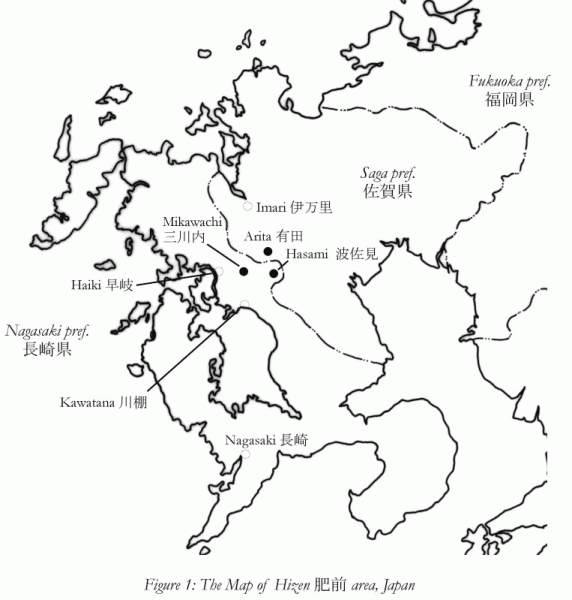
It was so fortunate for the Hizen porcelain industry that the amount of exported Chinese porcelain to Japan reduced from the middle of the 17th century due to the civil war by the dynastic change from Ming 明 to Qing 清 in China. As a result, the amount of production of Hizen porcelain increased, and the Hizen porcelain industry dominated the domestic market.
It was not only the Japanese market that wanted to obtain porcelain. Porcelain were in short supply in the market of Southeast Asia and other area as well. Therefore, Hizen porcelain started to be exported to the overseas' market instead of Chinese porcelain, and it was the Chinese junks and VOC ships that sent out Hizen porcelain from the Nagasaki port. For this reason, it was only the Chinese and the Dutch that were permitted to trade in Nagasaki under the rule of the Tokugawa shogunate until the middle of the 19th century. Teijiro Yamawaki 山脇悌二郎 presented the document that "inferior porcelain" were exported from Nagasaki to Cambodia via Thailand in 1647. He pointed out the possibility that the "inferior porcelain (porcelain in poor quality)" was Hizen porcelain, and he said that Hizen porcelain started to be exported to Indochinese Peninsula from about the late 1640's [1]. Koji Ohashi 大橋康二 discussed about several pieces of Hizen porcelain found in Vietnam and Indonesia. He pointed out that they included Hizen porcelains that were produced in the 1640's [2]. Moreover, the Qing dynasty closed his country between 1656 and 1684 to reduce the power of Zheng Chenggong (Coxinga) 鄭成功who kept resisting the Qing dynasty, because sea trade could support his power. After the export of Chinese porcelain almost stopped, Zheng Chenggong began to deal in Hizen porcelain, because he could not deal in Chinese porcelain. He became the most important merchant for exportation of Hizen porcelain. As a result of the poor quantity of Chinese porcelain for exportation, the number of kilns in Hizen suddenly increased, and most Hizen kilns produced porcelain for exportation. Moreover, Hizen porcelain spread in the overseas market. It has been known that many pieces of Hizen porcelain were found at the sites in Vietnam, Thailand, Cambodia, Malaysia and Indonesia (Figure 2).
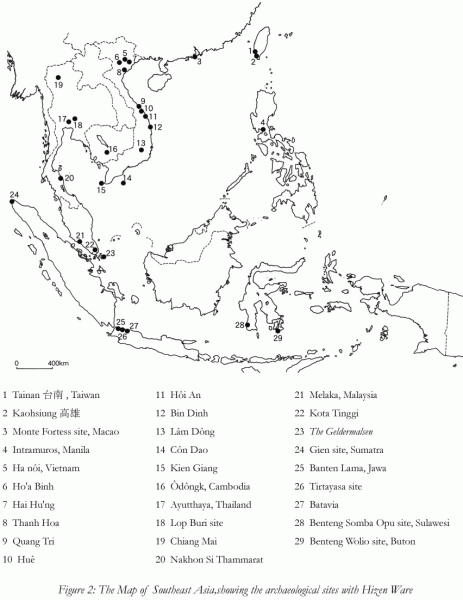
2. Hizen Porcelain Found in Asia; mainly Southeast Asia
Indonesia
In 1596 the Dutch came to Jayakarta and built warehouses and a fortress. Though the English also built their fortress in Jayakarta in 1615, the Dutch defeated the militaries of England and of Banten. The Dutch destroyed Jayakarta, and they rebuilt a castle and a new city. A new city was named Batavia. The city was used as an Asian trading center of the Dutch East-India Company (Verenigde Oost-Indische Compagnie or VOC). Some of the Dutch East-India Company warehouses still remain in seashore near the Batavia castle site. There is an old canal adjoining a group of the warehouses. When the canal was improved in 1980, many pieces of ceramics were unearthed. Name of the site is Pasar Ikan. Tsugio Mikami 三上次男 introduced about ceramics from there [3]. They included Hizen porcelain. In addition, Koji Ohashi also introduced and explained about Hizen porcelains found in the Pasar Ikan site, the Jalan Kopi site and the Banten Lama site [4]. The Jalan Kopi site is located at the central area of Batavia. Incidentally ‘Jalan Kopi’ means ‘the coffee street’. The Banten Lama site is located in the west of Jakarta by about 100km. Banten Lama was the capital city of the Banten kingdom. The team of Takashi Sakai 坂井隆 and Koji Ohashi has kept researching on Hizen porcelain in Indonesia. Up to now, they have researched on the ceramics unearthed at the Tirtayasa site, the Benten Wolio site in Buton Island and the Benten Somba Opu site in Sulawesi Island [5]. Ohashi is giving some comments on the characteristics of Hizen porcelain discovered in Indonesia as follows; they were not only for the Southeast Asia market, but also for the European market, because there was the base of the Dutch East-India Company; there are plates and dishes more than other regions.
Vietnam
Vietnam was one of the important markets for Hizen porcelain. It is one of the regions to where Hizen porcelain was exported from an early stage. Seiichi Kikuchi 菊池誠一 has reported Hizen porcelain found from Hoi An [6]. The Portuguese, the Dutch, the Chinese and the Japanese came to Hoi An by ships. It prospered as an international trade port from the end of 16th century. Koji Ohashi pointed out that there were a lot of cups and plates, and they are the characteristic types of Hizen porcelain found in Hoi An.
Thailand
Thailand was also an important market. Ayutthaya was the capital of Siam. It developed as an international trading city, especially the 16th through 17th centuries. There were Portuguese town and Japanese town. A factory of the Dutch East-India Company also was opened there in 1608. Koji Ohashi introduced many Hizen porcelain found around Ayutthaya [7]. For example, many porcelain were salvaged from Chao Phraya River in Ayutthaya. Although most of them were Chinese porcelain, they included 77 pieces of Hizen porcelain. Hizen porcelains were mostly large sized blue and white cups. And some pieces of Hizen ware, including stoneware, were also unearthed at the Lop Buri site and the Nakhon Si Thammarat site.
Cambodia
Oudong was an ancient capital and is located 40km away from Phnom Penh. There were the Japanese settlements in Oudong and Phnom Penh. Takako Kitagwa 北川香子 reported several Hizen porcelain found at Oudong in Cambodia [8]. They are mainly large sized blue and white cups.
Malaysia
In 1511 the Portuguese defeated Malacca and used as the main base for trading in Southeast Asia. Malacca however became just one of local ports of the Dutch East-India Company after the Dutch occupied it in 1641. Tai-kang Lu 盧泰康 reported two pieces of Hizen porcelain found in Malacca [9]: One is a blue and white dish with Karrack design, and the other is the celadon, which was produced in the Hasami kiln, Nagasaki prefecture.
Manila
In 1571 the Spain founded Manila City to control the Philippines and the Asian trade. Magellan crossed the Pacific Ocean half a century ago. The Manila Galleon trade route was established soon after Manila had been constructed. The route was functioned as the long and large sea trade route where the Asian world was connected with the American Continent until the early 19th century. However the subject concerning the galleon trade of Hizen porcelain has hardly been discussed; one of the reasons is that Hizen porcelain were not found in Manila, where was the base of Asia for the galleon trade. I therefore researched on ceramics in Manila to identify Hizen porcelain, and I found several pieces of Hizen porcelain for the first time in 2004 (Figure 3) [10]. At present I am researching on ceramics at the National Museum of the Philippines. Until now I have found about 60 pieces of Hizen porcelain in Manila. They are mostly blue and white dishes, especially with the design of Karrack ware.
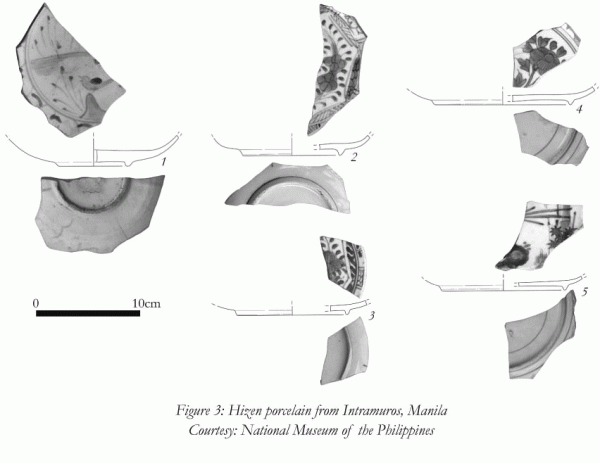
Macao
As for Hizen porcelain unearthed in the China continent, the specimens have been unearthed in Macao. The Portuguese came to Macao in 1513, and Macao became the Portuguese settlement in 1557. Macao had prospered by the trade with Nagasaki until Japan limited its gate for the outer world in the 1630’s. In 2005 I researched ceramics unearthed in Macao with Hung Hsiao-chung 洪曉純, Lu Tai-kang, and Wong Wai Yee 黄慧怡, receiving the cooperation of Museu de Macau and Museu de Arte de Macau. We found several pieces of Hizen porcelain among them [11]. They were unearthed at Monte Fortess site. Monte Fortess was the Portuguese fort completed in 1626.
Taiwan
Zheng Chenggong sent troops to Taiwan in 1661, and he had the victory over Netherlands in Taiwan in 1662. Then Tainan area was the main ground of his group until they were surrendered to the Qing dynasty in 1683. They engaged the triangular-trade of "China-Taiwan-Manila" or "Japan-Taiwan-Manila" between 1662 and 1683. Tainan area was therefore one of the most important relay-ports of Hizen porcelain trade.
Ming-liang Hsieh 謝明良 and Takashi Sakai presented several shards of Hizen ware unearthed in Taiwan; they were porcelain and stoneware produced at the late 17th century in Hizen [12]. Although they were specimens that showed the relationship between Hizen and Taiwan, they were not typical export goods for Southeast Asia and European world. In 2003-2004, several pieces of Hizen porcelain were found at the She-nei 社内 site excavated by Kuang-ti Li 李匡悌 (Figure 4) [13]. Tai-kang Lu, who analyzed the ceramics found at the She-nei site, noted about four pieces of Hizen porcelain, and he also gave me the information that a shard of Hizen porcelain was found under the construction of underground shopping area in Tainan 台南 city [14]. They included Hizen porcelain to export for Southeast Asia and European world [15]
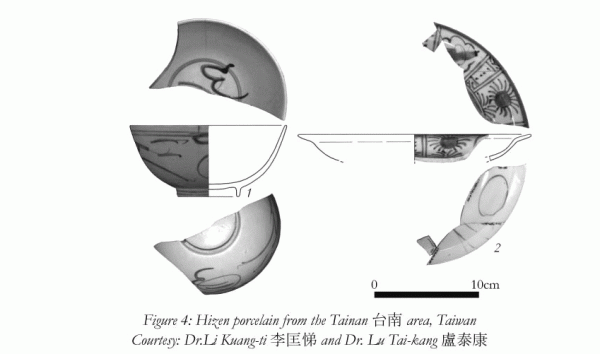
3. Hizen Porcelain Found in Africa (Figure 5)
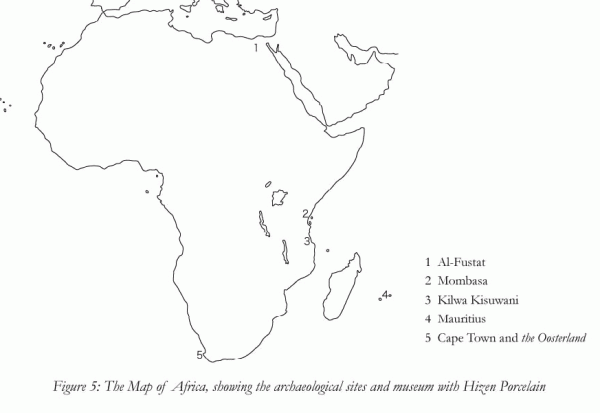
Mauritius
In 1505 the Portuguese came to Mauritius. And the Dutch set foot on land in 1598 and started to colonize in 1638. But the Dutch destroyed everything, when they left for Batavia. Then the France East-India Company ruled Mauritius from 1725-1767. Several pieces of Hizen porcelain were unearthed [16]: One was a shard of white porcelain jar, called albarello, and the others were pieces of blue and white dish with the design of Karrack. They were all produced at the Arita kiln for the European world market between the late 17th century and the first half of 18th century.
Cape Town
In 1652 the Dutch East-India Company started to colonize Cape Town as the supply base for the trade of Southeast Asia. Several pieces of Hizen porcelain were excavated at the Castle of Good Hope and Cape Town city [17]. Moreover the William Fehr Collection remains in the Castle of Good Hope [18]. The collection includes many Hizen porcelains such as blue and white dish with the VOC mark.
Mombasa
Mombasa was one of the bases for trading in the Indian Ocean. The Portuguese came to east Africa and built Fort Jesus in 1593. However, it was ruled by Oman power in 1697. Oman drove out the Portuguese from east Africa by the first half of 18th century.
There is a large jar in glazed polychrome enamel among the collection of the Fort Jesus Museum [19]. It was produced at the Arita kiln in the early 18th century, but we have little of knowledge about when it was brought to Fort Jesus.
Al-Fustat
Al-Fustat was founded as the capital of Egypt. After Arab defeated Egypt in 641, it flourished for the spice trade of the Red Sea and the Indian Ocean. A lot of shards of ceramics including Chinese porcelain and Southeast Asian celadon were unearthed, and a shard of Hizen porcelain was unearthed as well: It is a cup covered in polychrome enamel glaze [20]. The design is Kakiemon 柿右衛門style.
4. Hizen Porcelain Found in America
Mexico City
In Mexico City there was the ancient capital of the Aztec Empire. In 1519 Hernan Cortes came to Veracruz in Mexico. The Aztec Empire was perished by the power of Spain in 1521. Tenochtitlan, which was the capital of the Aztec Empire, was destroyed, and Mexico City was built on the ruin. Takatoshi Misugi 三杉隆敏 reported that four pieces of Hizen porcelain were unearthed in Mexico City under the construction of subway [21]. They were several pieces of blue and white dish with design of flowers and insects.
In 2006 I researched on ceramics unearthed at several sites near Templo Mayor in Mexico City. I finally found about ten pieces of Hizen porcelain (Figure 6), which include the same typed specimen found in Manila [22].
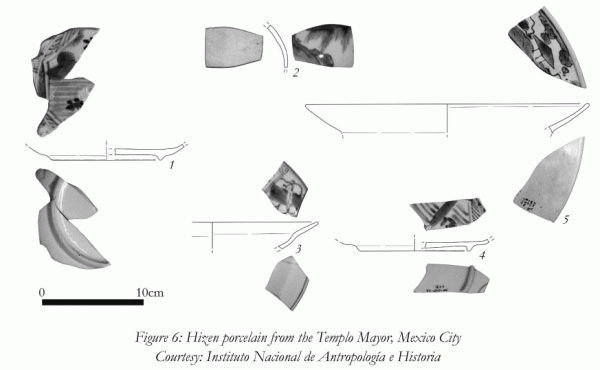
Guatemala City
Guatemala City was one of Spanish colonies and was founded in 1620. George Kuwayama introduced several shards of porcelain found in Guatemala [23]. He identified them all Chinese porcelain, but some of them are Hizen porcelain, and they are the same types of blue and white dishes as Hizen porcelain found in Manila.
Havana
In 1607 Havana became a capital of Spanish colonies in Cuba. Shigeko Tanaka 田中恵子 introduced several pieces of porcelain found in Havana [24]. They included a shard of Hizen porcelain. It is a blue and white chocolate cup. Koji Ohashi has supposed that it was produced in the 1650’s through 1670’s in Arita.
Discussion
SHIPS TRANSPORTED HIZEN PORCELAIN
Because of the policy of Tokugawa shogunate, only the Chinese and the Dutch ships entered the Nagasaki port. And only they could ship Hizen porcelain directly from Nagasaki to overseas. Did only the Dutch and the Chinese ships transport Hizen porcelain? The answer is No. For example, a shard of Hizen porcelain has been recovered from the Gotheborg, which was one of the ships of the Swedish East-India Company [25]. Even if she did not enter to Nagasaki and not buying Hizen porcelain directly there, her clues could have bought them in Batavia, Indonesia. For Batavia was one of the trading centers. This is the reason why other countries ships could have bought Hizen porcelain there.
CHINESE SHIPS
The Chinese ships exported mainly to the Southeast Asian market. Although there is no Hizen porcelain salvaged from the Chinese ships, it can be supposed that a Chinese ship or her cargo sank off Fukiage 吹上Beach, where is located in Kagoshima 鹿児島. A lot of shards of porcelain have drifted ashore on Fukiage Beach since the 1970’s. They are almost Hizen porcelain produced in the 1660’s. Koji Ohashi has mentioned that they were a part of the cargos for the Southeast Asian market [26]. We can find the same kind of them at the archaeological sites in Southeast Asia.
Hizen porcelains have been unearthed at the various archaeological sites in Southeast Asia. The Chinese ships played a big role to export toward Southeast Asian market. The Chinese ships exported many Hizen porcelain to Vietnam, Thailand, Cambodia, Indonesia, and etc.
DUTCH SHIPS
On the other hand, the Dutch ships exported to the Dutch factories in Southeast Asia, South Asia, West Asia and to the Netherlands via Cape Town. We know that Hizen porcelains salvaged from some Dutch ships. For example, the Avondster, the Oosterland, and the Geldermalsen.
The Avondster came to Japan in 1655 or 1656 and sank off Galle in Sri Lanka in 1659. A few pieces of Hizen porcelain, which were produced in Arita, were salvaged from her [27]; one is a blue and white dish with the design of Karrack and the others are blue and white albarello jars, which were imitation of delftware. The records of VOC showed that the Dutch East-India Company had ordered many ointment Jars for some hospitals in Taiwan and Batavia since the 1650's. The Oosterland sank off Cape Town in 1697. Several jars and bottles were salvaged from her [28]. They were white porcelain produced in Arita. The Geldermalsen sank near Singapore in 1752. Several pieces of shaving bowl were salvaged from her [29]. They were also produced in the Arita kiln, and many Hizen porcelains were found at several bases of the Dutch East-India Company. For example, Batavia, Cape Town and Mauritius were the bases of the Dutch East-India Company. So it is supposed that VOC ships transported most of Hizen porcelain found at their regions.
ARABIAN OR INDIAN SHIPS
The Islamic merchants played an active part for trading in the Indian Ocean. The Sadana shipwreck shows us the reality of their ceramic trade. The Sadana shipwreck was found in the Red Sea and excavated in 1995-1998. Many pieces of Chinese porcelain, which were produced in the 18th century, were salvaged from the shipwreck [30]. They included several porcelains as the collection of Topkap? Palace. Koji Ohashi has supposed that most of the ceramic collection of Topkap? Palace were brought via the Red Sea [31]. Perhaps some Islamic merchants bought Chinese porcelain at the trade port such as Batavia and then transported them to the Red Sea. I think that the Islamic merchants transported Hizen porcelain in the same way as Chinese porcelain between the late 17th century and the first half of 18th century. For example, we can find a piece of Hizen porcelain cup unearthed at Al-Fustat.
SPANISH SHIPS
I setup the hypothesis that Hizen porcelain was transported to the American continent by the galleon trade. But the subject concerning the galleon trade of Hizen porcelain was hardly discussed, because Hizen porcelain were not found in Manila where was a base of the Asian side for the galleon trade. I however researched on ceramics found in Manila to prove my hypothesis in 2004 and found several Hizen porcelains in the Philippines for the first time. These are concrete evidences that Hizen porcelain were imported into Manila. Moreover several Hizen porcelains were found at the Spanish colonies in the American continent such as Mexico City, Guatemala City and Havana. They were transported from Manila by the Spanish galleon ships. Hizen porcelain was imported into Manila via Taiwan by the Chinese ships. Some of them were used at Intramuros, and others were transported from Manila to the American continent by the galleon ships and used in the Spanish colonies.
Conclusion
Tokugawa shogunate had severely limited the overseas trade during Edo period. The Japanese were not allowed to go to abroad. Not only overseas trade ships, but also overseas trade seaport were severely limited. The Dutch and the Chinese ships only could enter to Japan and had directly trade relations with Japan. But they couldn’t trade without restraint either. They could trade on limited area inside the Nagasaki port. And the amount of trade was limited by Tokugawa shogunate too. Nevertheless we could find many Hizen porcelains all over the world. Not only the Dutch and the Chinese ships, but also other country’s ships transported Hizen porcelain. They show us that Japan also was a part of the trade network in those days.
Acknowledgements
My special thanks go to the following names for guiding my work with detailed comments;
Tatsuo Sasaki 佐々木達夫, Kenzo Hayashida 林田憲三, Koji Ohashi 大橋康二, Yoji Aoyagi 青柳洋治, Kazuhiko Tanaka 田中和彦, Hidefumi Ogawa 小川英文, Takashi Sakai 坂井隆, Hsiao-chun Hung 洪曉純, Kuang-ti Li 李匡悌, Tai-kang Lu 盧泰康, Wilfredo P.Ronquillo, Alfredo Orogo, Nida Cuevas, Cecilio G.Salcedo, Eusebio Z.Dizon, Rey A.Santiago, Amalia A.de la Torre, Ame M.Garong, Alexandra S.de Leon, Maharlika A.Cuevas, Ralph Leo M.Batoon, Sheldon Clyde B.Jagoon, Amelia D.Alhambra, Reynaldo A.Bautista, Giovanni G.Bautista, Chan Peng fai 陳炳輝, Lou Tai seng 盧大成, Moon Chio Ut hong 趙月紅, Roy Sit Kai Sin 薛啓善, Chan Chi leong 陳志亮, Eladio Terreros, George Kuwayama, Jose Alvaro Barrera Rivera, Alicia Islas Dominguez, Christine van der Pijl-Ketel, John N Miksic, Richard Pearson, Angela Schottenhammer, Barbara Seyock and Michael Moos
[1] Yamawaki, Teijiro 山脇悌二郎, “To, Ran sen no Imariyaki yushutsu 唐・蘭船の伊万里焼輸出 (The export of Imari ware by Chinese and Dutch ships)”, in Arita choshi hensan iinkai(ed.) . 有田町史編纂委員会編, Arita Choshi Shogyo hen 有田町史商業編Ⅰ(The History of Arita-cho Volume on Business). (Arita: Arita machi, 1988), pp. 265-410.
[2] Ohashi, Koji 大橋康二, “Hizen porcelain exported toward Southeast Asia”, in The Kyushu Ceramic Museum (ed.), Umi wo wattata Hizen no yakimono Ten 海を渡った肥前のやきもの展 (Hizen Ceramics Abroad)( Saga: The Kyushu Ceramic Museum, 1990), pp. 88-176.
[3] Mikami, Tsugio 三上次男, “Pasar Ikan iseki shutsudo no boueki touji パサリカン遺跡出土の貿易陶磁(Trade Ceramics Found in Pasar Ikan Site)”, Boueki toji kenkyu 貿易陶磁研究(Trade Ceramics Studies), No.2 (1982), pp. 112
[4] Ohashi, Koji 大橋康二, “Hizen porcelain exported toward Southeast Asia”, in The Kyushu Ceramic Museum (ed.), Umi wo wattata Hizen no yakimono Ten 海を渡った肥前のやきもの展 (Hizen Ceramics Abroad). ( Saga: The Kyushu Ceramic Museum, 1990), pp 88-176.
[5] A Study of Ceramic Trade on the Tirtayasa Site, Banten, Indonesia, The Strategic Point through the Ocean Silk Road, Bulletin of the Research Center for Silk Roadology, Silk Roadology 20. (2004).
Excavation Research Report of Tirtayasa Site, Banten, & Wolio Castle Ruins. Buton (Gunma: NPO Association of Asian Cultural Properties Cooperation, 2007)
[6] Hoian no koukogakuホイアンの考古学調査, Showa joshi daigaku kokusai bunka kenkyujyo kiyou昭和女子大学国際文化研究所紀要, vol.4. (1997).
[7] Ohashi, Koji 大橋康二, “Hizen porcelain exported toward Southeast Asia”, in The Kyushu Ceramic Museum (ed.), Umi wo wattata Hizen no yakimono Ten 海を渡った肥前のやきもの展 (Hizen Ceramics Abroad).( Saga: The Kyushu Ceramic Museum, 1990), pp. 88-176.
[8] Kitagawa, Takako 北川香子, “ Udon Site, Cambodiaカンボジア・ウドン遺跡” in Banten, Tirtayasa iseki hakkutsu houkokusho, バンテン・ティルタヤサ遺跡発掘報告書( Tokyo: Institute of Asian Cultures, Sophia University, 2000), pp. 78.
[9] Lu,Tai-kang 盧泰康, “Malacca no Hizen jiki boueki マラッカの肥前磁器貿易”(Trade of Hizen ware in Malacca) , in Suichu koukogaku kenkyu 水中考古学研究(The Journal of Underwater Archaeological Studies) No.1(2005), pp. 98-103.
[10] Nogami,Takenori 野上建紀, Alfredo B. Orogo, Tanaka, Kazuhiko 田中和彦 and Hung, Hsiao-chun 洪曉純“Manila shutsudo no Hizen jiki マニラ出土の肥前磁器( Japanese Porcelain found in Manila)” in Kindai kouko 金大考古48 (2005), pp. 1-5
[11] Nogami,Takenori野上建紀, “Macao shutsudo no Hizen jiki 澳門出土の肥前磁器(Hizen porcelain found in Macao)” in Kindai kouko 金大考古50 (2005), pp. 7-11.
[12] Hsieh Ming-liang 謝明良, Zuoying Qingdai Fengshan xian jiucheng jule chutu taoci buji 左営清代鳳山県旧城聚落出土陶瓷補記 (Supplement on Ceramics excavated from Fengshan walled city in Zuoying of Qing Dynasty), Taiwanshi Yanjiu 台湾史研究 (The Studies of Taiwan History).Vol.3, Institute of Taiwan History, Academia Sinica 中央研究院台湾史研究所 (1996).
[13] Li, Kuang-ti 李匡悌, Sanshe ji Shenei yizhi shouxiang shuili gongcheng yingxiang fanwei qiangju kaogu fajue gongzuo jihua 三舎及社内遺址受相関水利工程影響範囲搶救考古発掘計劃 (Rescue Excavation at Sanshe and Shenei), (Taiwan: Tainan County Government and Institute of History & Philology, Academia Sinica, 2004 ).
[14] Lu Tai-kang gave me the information about Hizen porcelain unearthed in Tainan City, when I researched on ceramics in Taiwan in 2005.
[15] Nogami,Takenori 野上建紀, Li, Kuang-ti 李匡悌, Lu,Tai-kang 盧泰康 and Hung, Hsiao-chun 洪曉純, “ Tainan shutsudo no Hizen jiki台南出土の肥前磁器 (Hizen porcelain found in Tainan) in Kindai kouko 金大考古48(2005), pp. 6-10.
[16] Kim Spijker, The Unknown pottery of Mauritius (2001).
[17] Jane Klose, “Excavated Oriental Ceramics from the Cape of Good Hope: 1630-1830” in Transactions of the Oriental Ceramic Society. The Oriental Ceramics Society, (1993), pp. 69-81
[18] Koimari no michi 古伊万里の道, The Kyushu Ceramic Museum 佐賀県立九州陶磁文化館 (2000).
[19] Suzuki, Shigeharu 鈴木重治, “Kenya, Tanzania shutsudo no chugoku toujiki-1987nendo no tousa kara ケニア・タンザニア出土の中国陶磁器?1987年度の踏査から” in Boueki touji kenkyu 貿易陶磁研究 No.9(1989), pp. 76-88.
[20] Touji no touzai kouryu 陶磁の東西交流, Idemitsu Museum of Arts 出光美術館 (1984).
[21] Misugi, Takatoshi 三杉隆敏, Sekai no sometsuke 世界の染付 (Blue and White Ceramics of the world) 6, (Tokyo, Dohosha shuttupan同朋社出版, 1986).
[22] Nogami,Takenori 野上建紀, Eladio Terreros, George Kuwayama, Jose Alvaro Barrera Rivera, Alicia Islas Dominguez and Tanaka Kazuhiko 田中和彦, “Taiheiyo wo wattata toujiki-Mexico hakken no Hizen ji wo chushin ni-太平洋を渡った陶磁器?メキシコ発見の肥前磁器を中心に” in Suichu Koukogaku Kenkyu 水中考古学研究(The Journal of Underwater Archaeological Studies) No.2(2006), pp. 88-105.
[23] Kuwayama, George and A. Pasinski, “Chinese ceramics in the Audiencia of Guatemala” in Oriental Art XLV: 4 (2002), pp. 25-35.
[24] Tanaka, Shigeko 田中恵子 went to Cuba in 2006, and sent me some photos of ceramics found in Havana. And Ohashi Koji found one piece of Hizen porcelain among them.
[25] Berit Wastfelt, Bo Gyllensvard and Jargen Weibull, Porcelain from the East Indiaman Gotheborg (Wiken, 1990).
[26] Ohashi, Koji 大橋康二, “Kagoshima ken fukiagehama saishu no touji hen 鹿児島県吹上浜採集の陶磁片” in Mikami Tsugio hakase kiju kinen ronbun shu touji hen 三上次男博士喜寿記念論文集 陶磁編, (Tokyo: Heibonsha平凡社, 1985), pp. 275-291.
[27] Nogami,Takenori 野上建紀 and Christine van der Pijl-Ketel, “Avondster gou hakken no Hizen jiki アーヴォンド・ステレ号発見の肥前磁器(Hizen Ware Found from the Avondster)” in Suichu kuokogaku kenkyu 水中考古学研究(The Journal of Underwater Archaeological Studies) No.2(2006), pp. 74-77.
[28] Bruno E.J.S.Werz and Jane E.Klose, “Ceramic analysis from the VOC ship Oosterland(1697)”, in South African Journal of Science, vol.90 (1990), pp. 522-526.
[29] C.J.A.Jorg, The Geldermalsen History and Porcelain, (Kemper Publishers Groningen, 1986)
[30] George F. Bass, Beneath the Seven Seas, (Thames & Hudson, 2005).
[31] Ohashi, Koji 大橋康二, “ Osman Toruko teikoku no seisui to toyo touji オスマン・トルコ帝国の盛衰と東洋陶磁” in Topkapu kyuden no meihin-surutan no aishita toujiki トプカプ宮殿の名品?スルタンの愛した陶磁器, Saga kenritsu Kyushu touji bunka kan佐賀県立九州陶磁文化館, (Saga: The Kyushu Ceramic Museum, 1995), pp. 117-128

